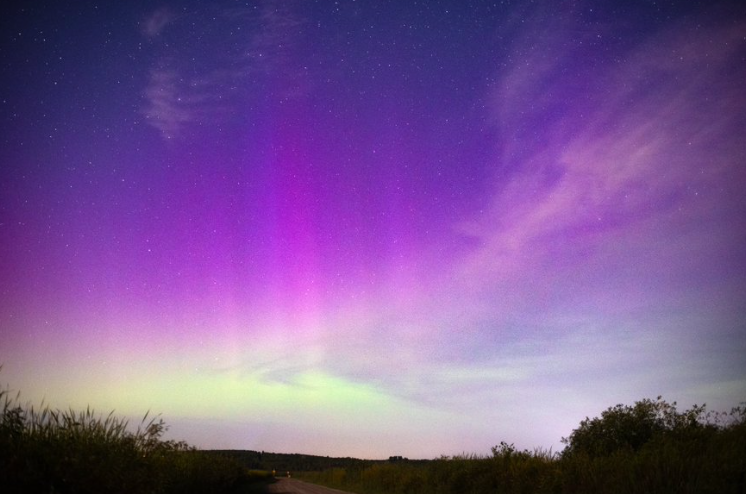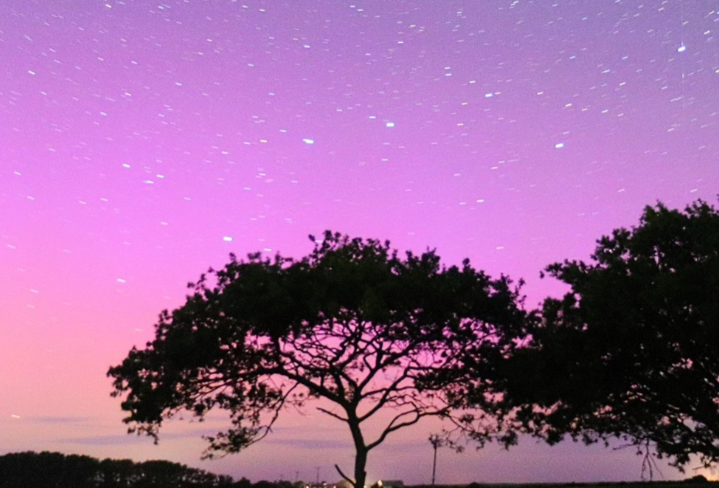Scientists report that a fast-moving coronal mass ejection (CME) from the sun on Aug. 30 has set the stage for an aurora borealis light show this week. According to NOAA’s Space Weather Prediction Center, the CME from sunspot AR4199 is expected to hit Earth late Sept. 1 (Labor Day) into Sept. 2, triggering a moderate-to-strong geomagnetic storm. Such geomagnetic storms occur when charged solar particles collide with Earth’s magnetic field and atmosphere, causing gases to glow. Oxygen atoms high above Earth glow red or green, while nitrogen at lower altitudes can produce purple or pink hues. In effect, the sun’s storm could paint the sky with colorful ribbons of light.

The NOAA watch for Sept. 1–2 is for a G2 (moderate) to G3 (strong) storm. Forecasters say this is no ordinary flare – it has the potential to push the aurora well beyond its usual polar regions. As The Washington Post notes, sky-watchers in “Michigan, Wisconsin, Minnesota, the Dakotas, Montana and Washington state could see some of the most dazzling shows” in the lower 48 states. In those areas, forecasts call for mostly clear skies overnight to help the view. “The northern lights may return to the night sky over Canada and parts of the United States tonight,” the CBS News space blog reports. This storm is likened to a “cannibal CME,” where one solar eruption overtook another en route to Earth, amplifying the effect.
Auroras are notoriously unpredictable, but models show peak activity arriving in the pre-dawn hours. NOAA’s latest Kp index forecast predicts the strongest disturbance between about 2 a.m. and 5 a.m. ET on Tuesday (Sept. 2). That means late Monday night into early Tuesday will be prime viewing. Observers are advised to watch as soon as darkness falls and especially near the 2–5 a.m. window. Meteorologists stress the importance of dark, clear skies: the aurora is best seen from quiet, low-light areas with an open view north. Indeed, local weather reporters remind viewers to “find a dark spot away from city lights” and be patient – the lights often appear faintly at first. Even a modern smartphone in night mode can capture colors that the eye might miss.
The Space Weather Center has warned that a G3 (strong) storm could materialize overnight. In practical terms, this means the aurora band may dip unusually far south. The Weather Network’s forecast graphic (above) highlights a G3 risk late Monday and early Tuesday across North America, with NOAA data on aurora strength. Under these conditions, auroras may become visible deep into the mid-latitudes. While Alaska and northern Canada will surely glow, this storm could also spark visible lights in the continental US. Official guidance lists 18 states in the potential viewing zone – broadly including Minnesota, Wisconsin, Michigan, New York, Idaho, Washington, Oregon, Illinois, and others as far east as Maine and Vermont. (Notably, Ohio is not on NOAA’s official map, though observers along Lake Erie may still keep watch for any faint glow southward.)
ALSO VISIT
Northern Lights Across the United States

Forecasters say much of the U.S. Midwest and Great Lakes region will have a shot at seeing green-and-red skies. In Michigan, for example, Fox17 Detroit reports NOAA’s watch for a G3 storm could “bring the Northern Lights to Michigan” Monday night. Meteorologists there note the CME will arrive late Monday, and a Kp index around 7 (G3) would make auroras active across the state. Similarly, in Chicago, Fox 32 weather warns that a G2 storm watch means a chance for northern lights. Clear skies are expected, giving Illinois residents a chance to look north for any glow. The Chicago station advises finding a dark horizon and that smartphone cameras may reveal colors that seem faint in person.
In Wisconsin, the FOX6 Milwaukee team highlights the “best chance of seeing the northern lights is from 12 a.m. to 3 a.m.” on Sept. 2. They note a strong geomagnetic storm (G3) is forecast, which “means bright auroras could be visible much farther south than usual”. Indeed, Wisconsin could see a visible green glow over much of the state if conditions peak. And while the far southern U.S. (e.g., Texas, Florida) remains out of reach, NOAA maps show that even parts of upstate New York and New England might catch a glimmer in clear northern skies.
Canadian Perspectives and Ontario Forecast
Canadian meteorologists have issued similar alerts. The Weather Network (a Canadian forecast site) reports that NOAA has declared Sept. 1–2 a Level 2–3 geomagnetic storm watch for Canada and the northern U.S.. They emphasize this is “the best chance since spring to catch the northern lights” in much of Canada. As autumn nights lengthen, Canadians from the Prairies through Ontario and Quebec will want to look north after dark. In fact, The Weather Network specifically points out that “whether you’re in the Prairies, Ontario, Quebec, or even the northern U.S., this week’s skies could be worth staying up late for”.
Mapping software from The Weather Network (above) shows the expected aurora glow over North America. Their graphics suggest a broad green auroral band covering Canada and reaching into the U.S. northern tier. Night-sky enthusiasts in Ontario and Quebec are particularly hopeful. Southern Ontario could see northern lights on the horizon if the forecast holds. One Ontario weather blogger on Platform X posted:
“It looks like tonight is shaping up to be a good one for northern lights viewing across Southern Ontario! Conditions are now favorable for the aurora to show up along the northern horizon once darkness settles in over the next hour. The geomagnetic storm has just hit G2 strength, which is typically when we start to see the northern lights become visible in our region. To give yourself the best chance, head somewhere away from city lights. If you don’t see it right away, try using your phone camera with night mode and max exposure. Often your camera will pick up the lights before your eyes can. We’ll update as soon as we receive the first report. Stay tuned!”
This post echoes official advice (e.g., from Environment Canada and amateur astronomers) to find dark sites and use a camera’s long exposure. As Fox Milwaukee notes, “colors will not look as vibrant to the human eye, so use your cell phone on night mode to try and capture the array of colors”. In fact, the US Centers for Space Weather say people should give their eyes about 10 minutes to adjust to darkness and not be discouraged if the lights start to feel faint.
Northern Lights in the UK and Europe
The same solar storm has European forecasters excited. The UK’s Met Office issued a forecast on Sept. 1 saying the incoming CME “could allow the aurora borealis… to be visible further south than usual,” and that the aurora might be seen across much of the UK if skies are clear. As The Independent reports, Northern Lights already appeared over Britain on Monday night. UK stargazers posted photos from northeast Scotland, northern England, and the Midlands (and even Ireland), as a CME-driven geomagnetic storm lit the night sky. The Independent notes the Met Office forecast that on Monday (Sept. 1) through Wednesday, viewing conditions would allow the aurora “as far south as East Anglia and the Midlands”. Their meteorologist, Krista Hammon,d reminded the public that forecasts can change rapidly and to stay updated.
British media and social posts have been abuzz. For example, GB News (a UK outlet) headlined that the lights “will brighten up UK skies tonight, as far south as Birmingham and Norwich.” The Met Office warned that a waxing gibbous moon could wash out faint glows and that low clouds might hinder some viewers. Still, in the northern parts of Scotland and England, many witnessed a vivid green arc overhead. On social media, meteorologists celebrated Monday’s display. One UK forecaster wrote on Platform X:
“Northern Lights delivered last night from Scotland, north Wales and even down to Norfolk and Kent! Increased solar activity likely to continue tonight with chance of a stronger display.”
Another tweet added:
“Good morning! Stunning display of the northern lights from Shetland to Norfolk last night, following enhanced solar activity.
Another display poss tonight, but likely limited to parts of Scotland
📷 Bonar Bridge, David
📷 Ramsay, Griff on the Beach
📷 Somerton, KeepOnRunning”
And a UK weather service account posted early Tuesday:
“Exciting news for sky watchers! A solar storm could light up UK skies tonight, with a rare chance to see the Northern Lights as far south as the Midlands. Clear skies offer the best views. Don’t forget to share your photos!”
These posts underscore how widely the aurora was seen and shared. Forecasters reiterate that any sighting depends on local weather, light pollution, and moonlight. But with several agencies confirming at least a moderate (G2–G3) storm, observers are hopeful.
Tips for Chasing the Aurora
In all regions, experts emphasize patience and preparation. The NOAA and Met Office both stress staying tuned to updates: space weather conditions can change quickly. Viewers should aim for minimal light pollution – national parks or remote countryside locations – and check the night’s cloud forecast. Bring warm clothing, and if possible, use a tripod or steady surface for long-exposure photos. Smartphones with “night mode” can capture the faint green glow even before it’s obvious to the naked. Keep in mind that many auroras may simply appear as a dim green “haze” on the horizon rather than dramatic curtains. As Fox Chicago bluntly notes: “photos online often look more vivid than what the naked eye sees”.
If the skies clear after midnight, sky-watchers from northern New York through the Midwest will have the best chance. In the UK and Canada, those under dark northern skies should look northeast to northwest after 10 pm local time. Observers in marginal areas (Ohio, New York, northern England, Wales, etc.) may need to focus on their northern sky with a camera pointed upward. Across both hemispheres, this storm is expected to continue through Tuesday night, though activity may wane by Sept. 3.
Ultimately, scientists caution that even a strong storm might only produce a brief or patchy show. Nevertheless, this event is already being called the best aurora opportunity since spring. Sky-watchers and social media alike are poised with cameras, hopeful for a rare celestial display. Sources at NOAA and the Met Office will continue to issue updates, and dozens of weather outlets across North America and Europe have published real-time maps and forecasts for where to look. If you have a chance tonight, step outside and glance north – you might catch the green glow dancing across the midnight sky.
